Scars - what are they? Many people know the answer to this question. However, not everyone knows what types of scars exist and whether it is possible to get rid of them forever. We will talk about this further.
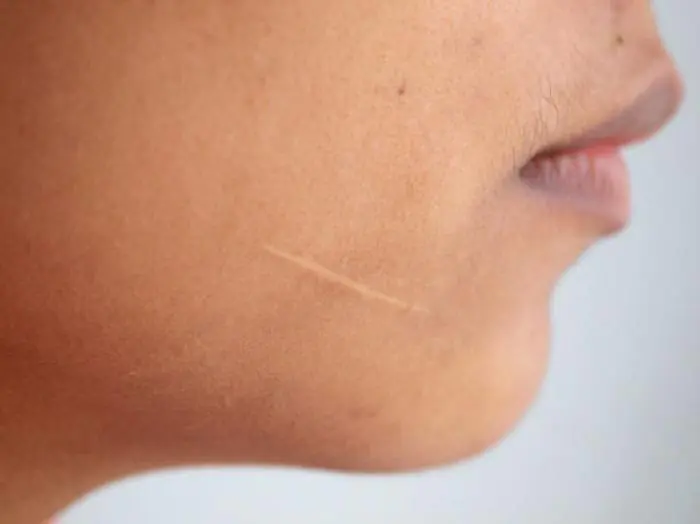
basic information
Scars - what are they? According to experts, this is a dense connective tissue formation that occurs due to tissue regeneration after inflammation or damage (for example, a trace left on the skin after healing of a wound, in the myocardium after a heart attack, in the duodenum after healing of ulcers and etc.).
What does a scar consist of (a photo of a banal scar is presented in this article)? Scar tissue is composed primarily of collagen. As a rule, it differs from those integuments that it replaces by reduced functional properties. How does this manifest itself? Doctors report that scars left on the skin after a wound are more sensitive to solar radiation. They do not restore hair follicles and sweat glands. A scar in the heart muscle that occurs after a myocardial infarction does not participate in its contraction and can also cause the development of heart failure.
It should also be noted that some tissues, including bone, are capable of significantly restoring their function and structure after damage.
Reasons for appearance
Scars – what are they and why do they occur? Such scars are a banal trace left at the site of a healed wound.
As you know, the human body independently fights absolutely any damage. And skin wounds are no exception. However, it should be noted that after healing, the integument at the site of injury becomes completely different. This is especially true in cases where an inflammatory process occurs during skin restoration.
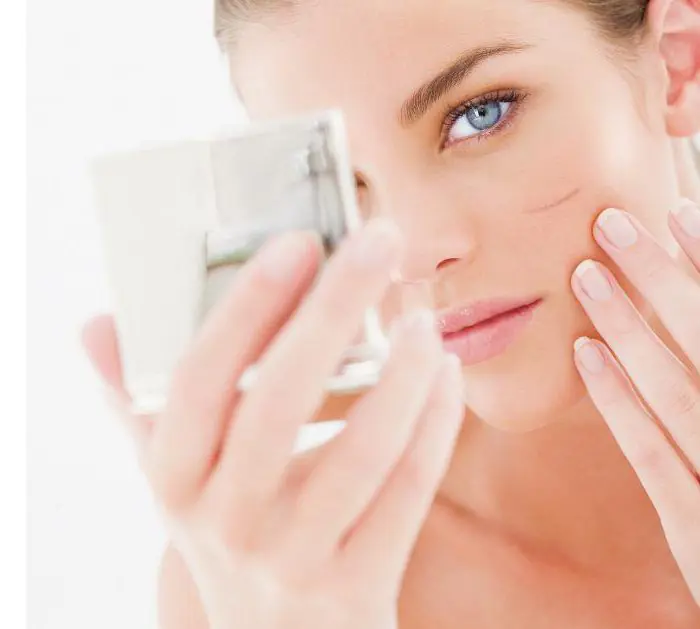
The connective tissues that allow the skin to regenerate differ from ordinary ones in their properties. Their functional properties are much lower. Therefore, neither the sweat glands nor the hair follicles are restored at the site of the scar.
Scar tissue also differs in appearance from normal tissue. Fresh scars have a dark tone, but over time they, on the contrary, noticeably lighten.
Scars - what are they and what are they? Experts distinguish several types of scars. Moreover, in each individual case the human body will cope with them differently.
The appearance of scars depends quite a lot on the general condition of the person, his age, the nature of the damage and skin type. For example, operations usually end with smooth linear scars, since surgeons sutured the wound, carefully connecting its edges.
If the injury was extensive and healed on its own, then the trace from it will be much more noticeable. Also, depending on the individual characteristics of the patient, hypertrophic or atrophic scars may appear at the site of any skin damage, the causes of which can be serious injuries.
So what kind of scars are there? Let's look at their features right now.
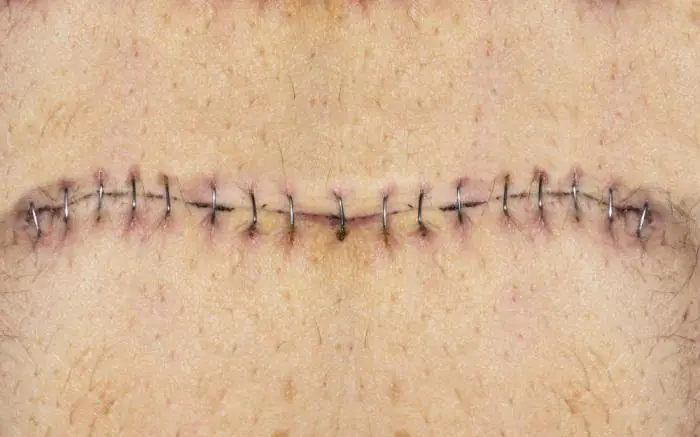
Acne scars
Pimples that appear on the skin gradually heal, and red or brown spots almost always remain in their place. As a rule, they are temporary and disappear after 2-6 months.
Experts say these are not real scars. Real scars remain after acne, which are formations in the form of a pit or tubercle.
The appearance of such scars most often occurs with cystic acne, and less often - after resorption and healing of pustules. Such scars are denser than the skin surrounding it. They can be convex, appear as “craters” and scar-holes.
How to get rid of such traces? Treatment depends on the type and number of scars. The most common ways to treat such scars are: subcision, excision, skin grafting, dermabrasion, laser radiation and hyaluronic fillers.
Operation scars
Scars usually heal quickly after surgery. But at the same time they are clearly visible. Why is this happening? Doctors say that there are a large number of factors that determine how postoperative scars will heal. The main thing is the load on the seams. The smaller it is, the faster the stitches heal, and the scar is more neat.
Postoperative scars recover well around the eyelids, as well as after cesarean section. This is due to the fact that there is a lot of loose skin in these places, so the sutures after surgery receive little stress.
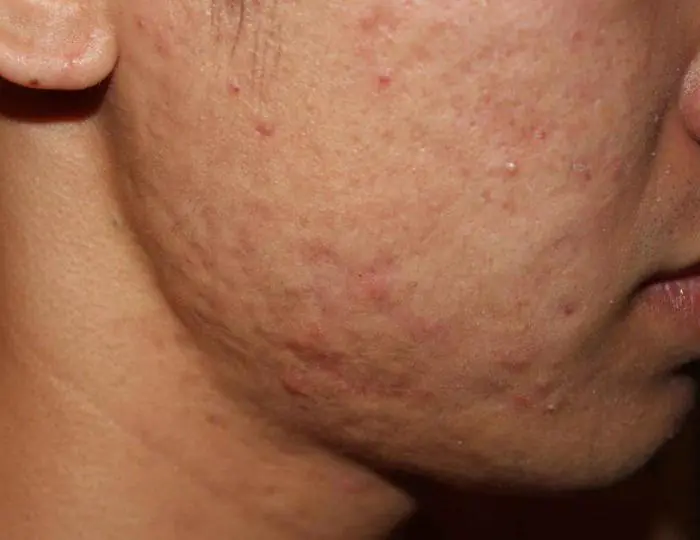
It should also be noted that scars after surgery heal more easily when the patient is older. Experts explain this by saying that over time, human skin loses its elasticity and becomes more stretched. The drawn-out seams on such covers are neat and not scary in appearance.
Most often, unsightly scars left after surgery form on the joints, in the décolleté area and on the back. This is especially true for those patients whose work involves lifting weights.
Hypertrophic and keloid scars
Photos before and after treatment of such a scar can be found in this article. This is a special type of scars, which is characterized by an increase in skin relief above the healthy skin around it. These scars are pink in color and also painful.
What are keloid scars? A photo of this footprint is presented in this article. According to experts, they are an inevitable consequence of almost any open injury. Such scars remain for life, creating significant cosmetic and functional defects for the patient.
Is it possible to get rid of these unpleasant and disfiguring marks on the body? Doctors say there are several ways to treat them.
If such scars have not yet appeared, then pressure on the damaged area is used to prevent their formation. It is provided through bandages that must be worn for 6-12 months.
How to cure already formed keloid scars? Photos before and after treatment for these scars vary significantly. If wearing a bandage is ineffective, then hormonal drugs are used. Surgical treatment of scars is also used. However, it is indicated only in cases of extensive skin damage and ineffectiveness of hormone therapy.
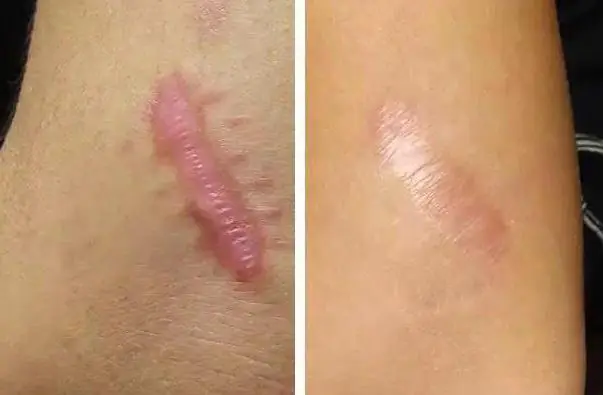
Experts note a fairly high frequency of relapses, so the operation is recommended to be performed no earlier than two years after the formation of scars, followed by preventive treatment.
Atrophic scars (causes and treatment)
Such scars are rather dense formations consisting of connective tissue. As a rule, they arise during the healing process of injured skin and are not capable of disappearing on their own.
Typically, the formation of such marks occurs only in those places where there is no subcutaneous fat. Such scars are mobile, pigmented and soft.
How to eliminate atrophic scars? Treatment at home does not bring the desired result. Therefore, many patients prefer to go to specialized clinics.
Today, there are a huge number of treatment options for atrophic scars. Most of them allow you to get rid of this unpleasant defect in a short time. These include the following methods:
- microdermabrasion;
- surgical excision;
- mesotherapy;
- use of creams, gels and ointments for scars;
- cutting scars, or so-called subcision;
- hydration;
- chemical peeling;
- enzyme therapy;
- laser therapy.
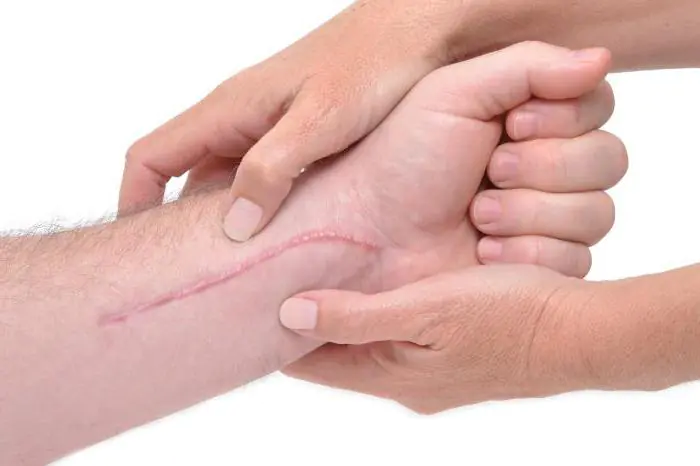
The choice of one or another technique should be made only by an experienced specialist, based on the current condition of the scar, an analysis of the reasons for its occurrence and the general condition of the patient.
Normotrophic scars
Such scars are located flush with the skin. As a rule, they are pale in color and do not give patients cause for concern. Most often, such defects are removed only in cases where they are located on the face or other open areas of the body. To do this, use the following procedures:
- microdermabrasion;
- physical therapy or enzyme treatment;
- therapy with ointments that contain biologically active substances that enhance microcirculation and cleanse the skin of bacteria;
- peeling, which allows you to remove some epidermal cells and even out the skin texture;
- cryomassage and cryotherapy (that is, treatment with liquid nitrogen);
- mesotherapy;
- surgical dermabrasion.
It should also be noted that good results in the treatment of normotrophic scars are achieved only by correction that was applied within six months from the date of scar formation. Older defects are very difficult to treat.

Let's sum it up
Now you know what scars are and what they are like. It should be noted that such scars are not always completely curable. However, modern medical technologies make it possible to make the marks left after wounds and operations less noticeable. Therefore, after discovering scars on your body, we recommend that you immediately contact a specialist. After all, only fresh scars respond best to treatment.
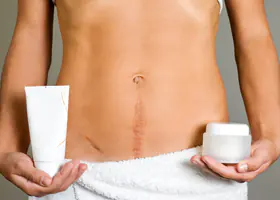
Scarring appear on the skin as a result of injuries and surgical interventions. Scars are a cosmetic problem for a person, and if the scar is very large, it can create discomfort and interfere with a person’s normal functioning.
How do scars appear?
Even small scars on the body can be a very serious problem. People are especially often concerned about how to remove a scar on their face. You can find out how to get rid of scars from a dermatologist, because in modern medicine there are many ways to get rid of scars.
Scars occur as a result of a violation of the integrity of the skin and its subsequent healing. The physiological structure of the skin is disrupted due to mechanical injuries, burns, skin diseases. As a result, the skin is replaced by connective tissue. Scars form not only on the skin, but also under the skin, that is, on the internal organs.
If physiological scarring occurs gradually and without disturbances, then the defects on the skin gradually decrease. As a result, the affected area turns pale and white scars appear on the skin. But the scarring process does not always occur without pathologies. The scar gradually acquires a purple tint, and the person develops red scars, which can be completely removed only after a skin graft.
In the process of scar formation, there are four stages that replace each other. At the first stage inflammation and epithelization, which lasts about 10 days from injury, swelling and inflammatory process gradually decreases. Granulation tissue forms at the site of injury, and the edges of the wound gradually move closer together. In the absence of infection, the wound gradually heals, a thin, barely noticeable scar appears.
At the second stage, which lasts from the 10th to the 30th day, an immature, loose scar is formed. It is pink in color because the blood supply to this area is increased. Third stage – this is the period of formation of a “mature” scar. It lasts in humans from the 30th to the 90th day. Gradually, the blood flow in the scar decreases, as a result of which the scar becomes denser and gradually turns pale. When three months have passed after the injury, fourth stageWhen the scar is completely transformed. The scar matures until about 12 months. At the same time, the collagen fibers gradually tighten, the scars become denser and paler. Only after the fourth stage can the doctor most accurately determine what condition the scar is in and what treatment methods need to be applied.
The more deeply the skin was affected, the longer the healing will be. Accordingly, the scar will be more pronounced.
Why do scars appear?
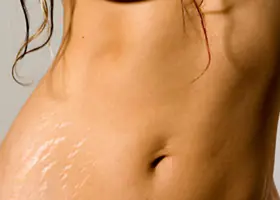
Scars on the skin appear as a result of mechanical injuries, burns, surgeries, etc.
Doctors distinguish several different types of scars in humans. If the scarring process proceeds normally, without complications, then a normotrophic scar. It is flat, its color is as close as possible to the color of the surrounding skin. Such scars, as a rule, are hardly noticeable; they do not cause much discomfort to a person.
Atrophic scars occur after acne or due to poor quality removal papillomas And moles. When such scars occur, the question of how to remove scars on the face is very serious for a person. Scars from acne on face are below the general level of the skin. Scar tissue becomes flabby as collagen production decreases. Accordingly, after acne, noticeable pits and scars may appear on the face, which are a serious cosmetic defect. However, in modern medicine there are many means to get rid of this type of scars. And if a cream or other local remedy is ineffective in this case, then laser facial resurfacing and a number of other procedures can almost completely remove such scars. Atrophic scars are also stretch marks (striae).
Hypertrophic scars protrude above the skin and have a bright pink color. In some cases, scars of this type partially disappear several years after the injury. But still, you should ask a specialist about how to remove a hypertrophic scar. If the treatment was correct, then such a scar can be eliminated almost completely. When visiting a doctor, the patient can look at before and after photos and evaluate how effective a certain procedure will be. The best result can be obtained with the help of surgical treatment, during which scar tissue is removed. If the treatment was carried out correctly, then at the site of a small hypertrophied scar the skin remains the same as after the removal of moles.
Keloid scars sharply limited and protrude strongly above the surrounding skin. As a rule, such scars are painful: even a keloid scar of the earlobe can periodically cause pain, burning, and itching. These scars are the most difficult to treat. Unlike hypertrophic scars, which clearly coincide with the injured skin surface, keloid scars can have a larger area than the damage.
Most often, keloid scars form on the ears, in the chest area, and in more rare cases - on the joints and on the face of a person.
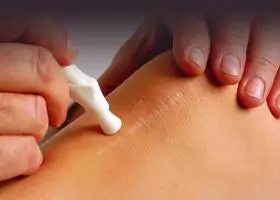
Keloid scars occur as a result of surgery, burns, vaccinations, insect or animal bites, and after tattoos. Sometimes scars of this type appear even without prior injury. Why exactly keloid scars appear on the human body, doctors have not yet established.
Keloid scars in the period from the third month of existence to approximately five years, they have a red color and a smooth surface, and continue to grow actively. Those scars, from the appearance of which five years have passed, gradually fade, become wrinkled, and in some cases their central part sinks.
Postoperative scars remain after surgery. Their size and features depend on the type of operation, as well as on the properties of the person’s skin. Resorption of postoperative scars occurs gradually. To evaluate the process of scar resorption, you can compare a photo taken a few days after surgery and an image of the scar several months later. Removal of postoperative scars is carried out using both surgical and a number of other methods.
Sometimes, during the formation of a postoperative scar, pathological processes occur that slow down resorption. Infiltration of the postoperative scar may occur 3-6 days after surgery. In this case, hyperemia of the edges of the wound is noted, a painful compaction appears, and symptoms of intoxication and inflammation develop. In addition, fistula or abscess postoperative scar. Less common is endometriosis of the postoperative scar of the anterior abdominal wall.
How to treat scars?
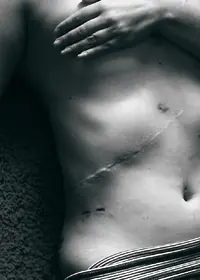
The scar healing process is influenced by: local, so are common factors. Therefore, immediately after an injury, it is impossible to say exactly what the scar will subsequently look like.
As local factors, the area that was injured should be taken into account, since the characteristics of the skin differ in different areas of the body. Also important are the actions of the doctor, who, with the right approach to treatment, can minimize the development of the scar in the future. Formation of a scar of envy and from the blood supply. The more active blood supply occurs in the injury area, the better the wound will heal. The nature of the injury is also important. If a person has received a burn or similar wound, then subsequently the scar will be more noticeable than when an incised wound heals.
Common factors include the patient’s age: young skin regenerates more actively. It is equally important what state the human immune system is in, since the activity of immune cells determines the production of collagen. Another common factor is genetic disposition. Each person has a number of individual characteristics that determine the characteristics of tissue regeneration.
To get rid of scars and prevent their occurrence, you should consult a doctor immediately after a serious injury. Very often, treating scars with folk remedies leads to the formation of a noticeable scar on the skin, which becomes a serious consequence for a person. Under no circumstances should a severe burn or serious skin damage be treated at home.
When visiting a doctor, treatment of the site of injury and the scar that forms on it is carried out depending on what stage of scar formation occurs.
At the first stage of scar formation, in order to avoid complications in the future, an atraumatic suture is applied to the scar, antiseptics are used, and regular dressings are performed. To prevent the edges of the wound from spreading, it is recommended to limit physical activity.
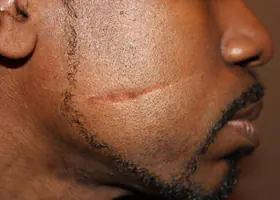
At the second stage of scar formation, dressings are performed if necessary. The patient should prevent further injury to the wound. It is also necessary to avoid stress so as not to damage the injury site. When the scar formation process enters the third stage, restrictions on physical activity are no longer necessary. But the doctor advises avoiding repeated injuries during this period, as this can provoke the formation of a keloid or hypertrophic scar.
Therefore, you should consult a doctor both if you receive an injury, and if the scar after surgery hurts for a long time. Only strict adherence to the specialist’s recommendations will speed up healing after surgery. In addition, it should be taken into account that after surgery an internal scar is also formed. Therefore, you should not use any scar treatment without prior consultation.
Modern medicine offers a lot of different means and methods for removing scars. However, it is possible to answer how to remove an atrophic scar on the face or how to get rid of other types of scars only after examination and studying the medical history.
If a person has formed almost imperceptible scars without pathology, then treatment can be carried out using cosmetics. Such products contain retinol, fruit acids, as well as other nutritional components. When using a cream or ointment for scars, it should be understood that such treatment must continue over a long period. Only after prolonged use will definite results appear. If a person has more serious scars, then their removal must be done using other methods.
Physiotherapeutic treatment promotes regeneration processes, blood circulation and granulation at the site of injury. Most often, scar treatment is carried out using ultrasonic phonophoresis and electrostatic massage. In the process of phonophoresis, medications are introduced into the skin layers using ultrasound. Electrostatic massage is the effect of an electrostatic field on human tissue.
Another effective method to destroy scar pigmentation is called photocorrection. Using this method, you can significantly improve the appearance of skin with hypertrophic, red atrophic, normotrophic scars.

For people who have visible scars, experts often prescribe laser resurfacing. Laser scar removal on the face, as well as on other areas of the body, involves layer-by-layer evaporation of connective tissue. Laser scar removal provides precise and fast removal of scars and scars. The procedure is not particularly painful. With the help of laser resurfacing, you can get rid of both scars after mole removal. So also from more serious scars resulting from injuries. Laser removal surgery is usually performed in combination with other treatment methods.
The cryotherapy method is the removal of scars using liquid nitrogen and ultra-low temperatures. Most often this method is prescribed for the removal of keloid scars.
To make a keloid scar less noticeable, injections are injected into its tissue. corticosteroid hormones. When using this method, pigmentation may appear on the skin for some time. If it is necessary to get rid of atrophic scars, injections of hyaluronic acid are performed.
Using peeling removes the top layer of skin cells. Cosmetologists prescribe peeling with fruit acids, which accelerate the production of elastin and collagen, even out skin texture, and get rid of pigmentation.
Chemical peeling allows you to polish scars, eliminating their boundaries and smoothing the skin. This peeling is used for all types of scars. However, to reduce hypertrophic scars, many such procedures and their gradual application are needed.
If the patient has atrophic scars that have formed recently, then treatment can be carried out using special gels and ointments.
The microdermabrasion procedure consists of fine grinding of the skin. This method not only removes scars, but also promotes skin rejuvenation and wound healing.
Keloid scars can be removed using radiation therapy. However, this method negatively affects the human body as a whole, so it is rarely used.
If it is necessary to reduce the area of scar tissue, surgical excision of scars is practiced. After surgical removal, the edges of the wound are fixed with a cosmetic suture. It is impossible to excise a fresh keloid scar, as a relapse may subsequently occur.
In order to prevent the formation of a large and noticeable scar, after an injury you must contact a qualified specialist who will do everything necessary for the subsequent process of tissue regeneration.
What is a scar? In general, a scar and a scar are one and the same thing, the only difference is in the country from which the term came. “Scar” migrated to us from Germany.
The scar itself is a skin seal, a patch to quickly restore the integrity of an organ or tissue. Yes, scars are not only skin, but also liver, myocardium, lung, etc. The scar has no special function; it only restores tissue function.
Clinical and morphological classification
The ideal outcome for any injury. The fabric completely fills the defect, but does not deform the surface of the skin. There is a slight difference in texture and shade, but not critical. Such scars do not require correction.
The result of normal regeneration. The peculiarity of this type of scar is that at the site of the skin defect, the scar is located as a small hole, a dip, or “minus tissue.” The shade is most often close to the skin, slightly whitish. This scar does not cause much discomfort, except in cases of scarring on open areas of the skin. The most common cause of acne is acne and chickenpox. Regarding acne, there are own classifications and methods of working with them.
This type of scar protrudes above the skin, the “plus tissue.” This type appears due to a failure in regeneration - the amount of elastin and collagen produced goes off scale. Scars of red and purple shades, dense, can deform tissues and cause not only aesthetic discomfort. Requires correction. The reason for their formation is considered to be secondary intention. That is, when the scar tries to strengthen, the skin experiences tension and tension, and the scar is formed according to the vector of its tension. Such a scar is not aesthetically pleasing, but it is unlikely to interfere with health in any way.
A pathological scar, which is classified as a pseudo-tumor skin disease. This species goes beyond the boundaries of the damage and begins to invade healthy skin, thereby increasing its area. This is a hyperexcess of collagen and elastin in tissues, a situation very similar in cellular composition to tumors. Like a swollen bright red surface that itches, tingles and continues to grow for years. The size of the scar significantly exceeds the size of the damage. For example, a defect the size of a pinhead can become covered with a scar the size of a coin. Unfortunately, there is no effective system for working with such scars yet.
The fundamental difference between a hypertrophic scar and a keloid.
- A hypertrophic scar never extends beyond the boundaries of the original damage. There was a 5 centimeter incision; there will be a scar of approximately the same size.
- The keloid scar will take over healthy tissue and grow. At some point, it may stabilize, but due to some influence on it, it will begin to increase again.
Stages of scar formation
I. Trauma and primary healing. 7-10 days
II. Formation of a young scar. 10-30 days
III. Formation of a mature scar. 30-90 days
IV. Final transformation or maturation of the scar. Period up to several years
Skin damage. What happens according to the stages?
- Inflammation,
- Cleansing the wound
- Primary healing.
At this point, it is important to avoid prolonged inflammation and suppuration. During this period, granulation tissue is formed - bright pink, young scar tissue. at this moment, a state of rest and absence of tension or friction is important. From 30 to 90 days, constant synthesis and decay occurs. We need the scar to be free from tension and friction.
After surgery, for example, they usually don’t tell you how to care for scars. But it is critically important that the rumen be at rest. There are special silicone gel coatings for this. Normally, everything will happen well and an atrophic scar will form. Other types will already require a complex system of correction and reconstruction of the scar. At the time of scar formation there should be no rough influences, stretching or friction, because the scar reacts to all external stimuli. Be careful!



